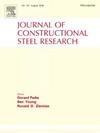Enhanced seismic resistance of welded steel grid frame with interstorey beams
IF 4
2区 工程技术
Q1 CONSTRUCTION & BUILDING TECHNOLOGY
引用次数: 0
Abstract
Experimental and analytical investigations of steel frames have mainly focused on connection design, with little attentive scrutinization paid to their ductility design. This paper presents a steel grid frame featuring the special interstorey beams that provides the same advantages as the ordinary steel frames, but with improved lateral stiffness and seismic performance. Accordingly, two comparative steel frames with the same steel consumption were constructed at a scale of 1:3, one of which consisted of the steel grid frame and the other of which was a standard steel frame. Two sets of frames were pseudo-statically tested under reversal load, their strain sequences and failure modes were investigated, and seismic indicators were compared including hysteresis curves, load-bearing capability, ductility coefficient, and energy dissipation. The experimental results indicate that the failure mode of the steel grid frame was mainly dominated by the interstorey beams. The interstorey beam is the primary component for energy dissipation and effectively realizes the seismic design concept of a strong column and a weak beam, thus achieving the goal of frame protection. The steel grid frame shows an increase of 3.54 % in the initial stiffness and an increase of 18.51 % in the ultimate load-bearing capacity compared to a standard steel frame. Its superior seismic performance is also demonstrated by an increase in the ductility coefficient from 30.5 % to 57.8 %. Consequently, the seismic performance of the weak-axis connected steel grid frame is superior to that of the strong-axis connected conventional steel frame, which is well-behaved in the numerical frame models.
增强带有层间横梁的焊接钢格栅框架的抗震性
对钢结构框架的实验和分析研究主要集中在连接设计方面,对其延展性设计关注甚少。本文介绍了一种具有特殊层间梁的钢网格框架,它具有与普通钢框架相同的优点,但侧向刚度和抗震性能有所提高。因此,我们以 1:3 的比例建造了两个用钢量相同的对比钢框架,其中一个是钢格栅框架,另一个是标准钢框架。两组框架在反向荷载作用下进行了伪静力试验,研究了其应变序列和破坏模式,并比较了滞后曲线、承载能力、延性系数和耗能等抗震指标。实验结果表明,钢格栅框架的破坏模式主要以层间梁为主。层间梁是消能的主要构件,有效实现了强柱弱梁的抗震设计理念,达到了框架防护的目的。与标准钢框架相比,钢网格框架的初始刚度提高了 3.54%,极限承载力提高了 18.51%。其优越的抗震性能还体现在延性系数从 30.5% 提高到 57.8%。因此,弱轴连接钢格栅框架的抗震性能优于强轴连接的传统钢框架,在数值框架模型中表现良好。
本文章由计算机程序翻译,如有差异,请以英文原文为准。
求助全文
约1分钟内获得全文
求助全文
来源期刊

Journal of Constructional Steel Research
工程技术-工程:土木
CiteScore
7.90
自引率
19.50%
发文量
550
审稿时长
46 days
期刊介绍:
The Journal of Constructional Steel Research provides an international forum for the presentation and discussion of the latest developments in structural steel research and their applications. It is aimed not only at researchers but also at those likely to be most affected by research results, i.e. designers and fabricators. Original papers of a high standard dealing with all aspects of steel research including theoretical and experimental research on elements, assemblages, connection and material properties are considered for publication.
 求助内容:
求助内容: 应助结果提醒方式:
应助结果提醒方式:


